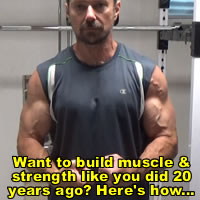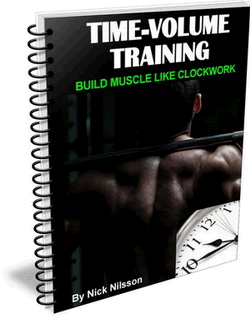By Nick Nilsson
Author of Time-Volume Training
When it comes to training, all exercises are NOT created equal. If you're looking to gain mass, you know the squat is going to add a lot more muscle to your legs than a leg extension.
However, did you know that focusing work on the greatest stretched position of a muscle can give you a similar advantage in muscle building?
Research has shown that placing high tension on muscles in their stretched position can have two extremely important effects on muscle building.
The first is greater activation of your muscle fibers - they fire in larger numbers, which is just what we need to build muscle. When you add tension to the muscle in the stretched position, you activate what is called the Myotatic Reflex (a.k.a. stretch reflex).
It's a reflex designed to protect the joints when heavy loads are placed on the muscles in the stretched position. To try and protect the joint, the body activates more muscle fibers to try and get that load out of the stretched position.
More fibers worked means more fibers growing.
The second important effect of stretch-position training, while being a potentially VERY powerful one, is still only a theoretical one. Because while no human studies have confirmed this effect, numerous animal studies have demonstrated it reliably, showing overall muscle size increases in the order of 300% (which is HUGE).
The effect is "hyperplasia," which means muscle fiber splitting (compare it to "hypertrophy," which means muscle fiber growth). When high tension is placed on the muscle in the stretched position, a single muscle fiber may actually split into TWO muscle fibers in response.
More fibers in the muscle means more overall potential growth! If you have more muscle fibers, it's just plain easier to build muscle. Having more muscle fibers is most likely one of the reasons some people just build muscle faster than others.
So how do we train to maximize muscle growth from the stretched positions of muscles?
We're going to utilize a technique I've come up with that I call "Pre/Post-Exhaust Stretch Giant Sets." It's a fancy name for a technique that is as effective as it is challenging and, to be completely honest, downright painful. Just know right up front that this is NOT a technique you can coast through, but if you're ready for some serious results, get ready to dig in...
To demonstrate this technique, I will use the chest as an example. You're going to be doing two exercises - dumbbell flyes and barbell bench press. But here's the key...you're not going to be doing the whole range of motion of either of them!
Part one of this giant set is the Pre-Exhaust.
Take dumbbells you could normally do about 10 to 12 full reps of dumbbell flyes with, lie down on a bench or Swiss ball and lower the dumbbells down to the bottom, stretched position.
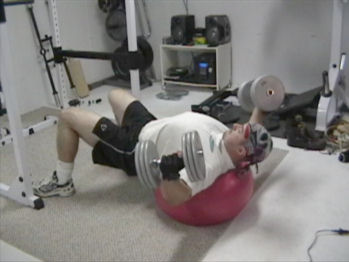
Now you're going to do partial, bottom-range reps of the dumbbell flye exercise. Let the dumbbells stretch your pecs at the bottom then, with a short, powerful movement, raise them up a couple inches.
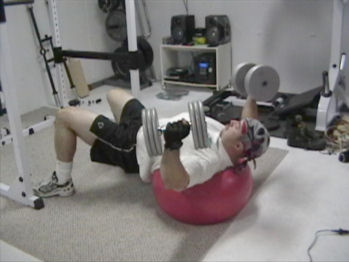
Now immediately bring them back down into the stretch position and hold, letting the pecs stretch. Perform as many reps as you can with this technique.
Part two of the giant set is continuous tension training.
Immediately get up and move to the dip station (you can also use the bench press for this). When doing dips, normally just using bodyweight should be fine. If you're using the bench press, before you start the giant set, you should pre-set the bar with a weight that you can normally do 12 to 15 reps with.
When doing dips for chest, you should have your body in a half-moon position, hunching forward and setting your elbows out wide to the sides. Look down as you're doing the reps to keep the tension on the pecs.
With dips, lower yourself down ALMOST to the very bottom.
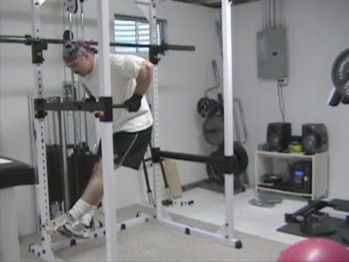
Then push yourself back up ALMOST to the top.
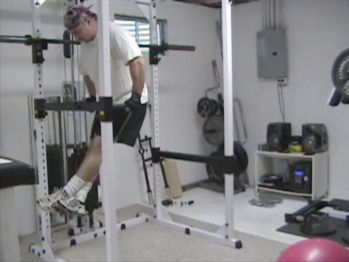
When doing bench press, unrack the bar and lower it to ALMOST the bottom position then, with no pause, press it back up to ALMOST the top position. With no pause, lower it back down to the same position as before.
What you are doing here is continuous tension training in the middle range of motion of the dip or the bench press. You're never getting a full stretch and you're never locking out. The pecs get NO rest during the entire set. Do as many reps as you can on the dips or the press then step down or re-rack the weight.
Now, if you thought the first two parts were hard, you're in for some fun...here's where it gets REALLY tough.
Go right back to the dumbbell flyes, get back into position on the bench or ball (using the same dumbbells as you were using before) and do ANOTHER stretch position partial set. This final post-exhaust set is going to really set off the alarm bells in your body!
So basically, the first set of partial flyes is going to take advantage of the increased muscle-fiber activation you get with a stretched-position exercise. Then, when you go into continuous tension pressing, more muscle fibers will be working under that continuous tension, increasing the results you get in terms of hypertrophy (fiber growth).
Now, when we get to the final partial flye set, the goal is hyperplasia (fiber splitting). The muscle fibers are exhausted and pumped up with blood from the first two parts of the giant set. Now the high tension in the stretched position is going to be a serious emergency to the muscle fibers and (hopefully) induce splitting of the muscle fibers.
It's a tough giant set but, when you're done, you'll know that you had a great growth-producing set.
"Pre/Post-Exhaust Stretch Giant Sets" can be done with ANY bodypart, making it a very versatile technique.
Here are some examples of exercises you can use with each bodypart:
Chest:
Any flye movement and any pressing movement
Back:
Dumbbell pullovers and any rowing or pulldown movement
Shoulders:
Cable lateral raises or leaning dumbbell lateral raises (leaning against a solid object with your working arm hanging down in front of you) and any pressing movement
Quadriceps:
Sissy squats and squats, split squats or leg press
Hamstrings:
Stiff-legged deadlifts and leg curls
Biceps:
Incline curls and any general curling movement
Triceps:
Any overhead tricep movement and dips or close grip presses
Calves:
Donkey calf raises and seated or standing calf raises
When incorporating this technique into your workouts, I would suggest doing no more than 3 or 4 of these giant sets for the back, chest or thigh muscles and no more than 2 or 3 for the other smaller muscles.
It's also not a technique you should use every training session - maybe once every week or two for a bodypart. It's very intense and demands a lot of recovery energy. Be sure you give your body and muscles the fuel they need to take full advantage of this potential growth.
Next try Antagonistic In-Set Supersets for your back and chest.
![]()
More From Fitstep.com
Share This Page...
---
Home -> Muscle and Strength -> Training Techniques -> Stretch Giants Sets


